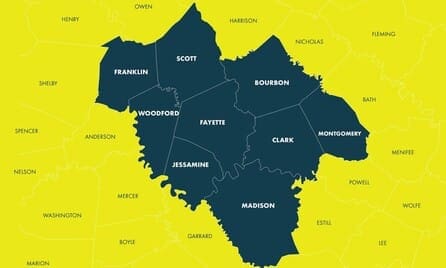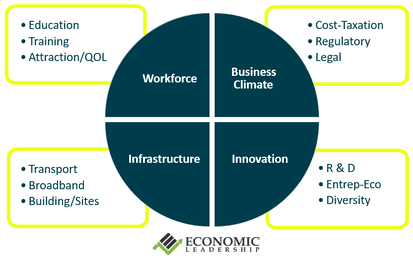Events over the past few years, such as the global pandemic, accelerated business disruption and have re-written what it means for cities and regions to be competitive for jobs and talent. Leaders in thriving communities (many that the Greater Lexington region competes against) are turning to regional collaboration to improve their competitive advantage and leverage resources more effectively.
Cities like Raleigh, Austin and Columbus are good examples of cities/regions where business and government leaders work together on a common vision for economic development and talent attraction to help their regions grow and prosper.

For many years, Commerce Lexington has worked within a 9-county region (700,000+ population) in Central Kentucky for job recruitment and retention activities, public policy advocacy and leadership development.
Given the rapidly changing economic landscape, Commerce Lexington, along with regional leaders, recognized the need to reposition and create the first-ever regional competitiveness strategy to elevate our regional approach. In 2021, Ted Abernathy with Economic Leadership was hired to evaluate global and national economic trends and the region’s economy; and assess regional strengths, weaknesses, growth opportunities.
He also examined how the region compares to competitor cites/regions based on key competitiveness factors in four overarching categories: business climate (taxes, regulations), innovation (entrepreneurial ecosystem, R&D investments), workforce development (education, training, attraction, quality of life) and infrastructure (roads, water/sewer, utilities/broadband, housing). Overall, the region ranked in the middle of the pack compared to other competitor cities (Nashville, Cincinnati, Indianapolis), but the region’s quality of life score was extremely high.

During the strategy development phase of this project, regional leaders in partnership with Commerce Lexington identified 6 key takeaways for the Greater Lex Bluegrass Region:
- The regional economy needs to be more competitive.
Despite having a highly educated workforce and excellent quality of life rankings, the region’s population, jobs, wages, and GDP growth lag many competitor communities and are well below the national average. - Regional wages need to rise.
Despite a highly educated workforce, the region’s current industry mix creates too few high paying jobs. Actions are needed to focus marketing and business support efforts on industries that raise the average wages across the region and are in high growth, higher wage sectors. - The regional labor force needs to grow with a targeted focus on young professionals.
The region’s labor force growth has been slow over the last decade. According to Economic Leadership, the region has only grown the labor force by 660 people each year on average, which is incredibly low considering the region has more than 20,000 students graduating from regional colleges and universities each year. A targeted marketing and internship connection strategy for talent attraction and retention is needed to bring more young professionals (25-45) to the region.Housing affordability is another policy issue regional leaders must address to help with talent attraction. Although the region is considered relatively affordable when compared with most competitor cities, low housing inventories and increasing prices threaten this advantage. For example, Fayette County’s average home value has increased 100% in the last decade, while wages have only increased by 30%. - More shovel-ready sites and buildings are needed in the region, including a regional mega-site business park.
Many businesses are seeking immediate availability of shovel-ready sites, or ready-to-occupy buildings. Due to infrastructure needs, zoning decisions, and the lack of speculative buildings, the region’s real estate product for job creation is limited. Actions to expand and improve the available buildings and sites are needed to successfully compete for jobs. The region is also at a competitive disadvantage to other regions because it lacks a “mega-site” business park (500+ acres of contiguous, shovel-ready land to land big projects). - Opportunities abound.
The Greater Lexington region has opportunities to grow the advanced manufacturing, business services and technology sectors. Quality of life is a strong advantage for the region, but many perspective talent and job creators have limited knowledge of what the region has to offer. Increased investments in talent attraction and business sector marketing to key markets and audiences are needed to capitalize on this advantage. - Data analytics are important and should be regionally focused.
Counties in the region are working to grow and improve, and these efforts are important. Detailed data about the region should be accessible online so prospective talent, site selectors and job creators can find it easily. Investors often look to regional data for comparison. Labor pool, housing availability, cost of doing business, business sites and many other factors are aggregated at the regional level by site selectors and compared to other regions across the country. Regional assessment, collaboration and alignment of key performance metrics are imperative to success.
Over the next five years, Commerce Lexington, regional business leaders, and local government leaders are committed to implementing a Regional Competitiveness Strategy based on these key takeaways. The big picture goal of the Regional Competitive Strategy is to increase the regional jobs, wages and GDP to the national average, and grow the labor force by 1,500 people per year. The Regional Competitiveness Strategy is focused on seven key items:
- Creating a unified regional brand identity
- Elevating economic development marketing to job creators and site selectors in key sectors
- Educating regional leaders about what is needed to be competitive and increasing partnerships
- Deploying a talent attraction and retention marketing campaign
- Increasing internships and work experiences for students with businesses
- Investing in regional business parks and infrastructure
- Advocating for government policies and investments to improve the business climate, housing affordability and meet infrastructure needs.
Regional collaboration can be difficult, but it is necessary for success when competing against much larger metros.
To learn more about the Regional Competitiveness Strategy and the action initiatives, click here.
You can also learn more about The Regional Competitiveness Strategy by attending The Regional Summit on November 29, 2023, at the Hyatt Regency in Lexington. For more information, go here.